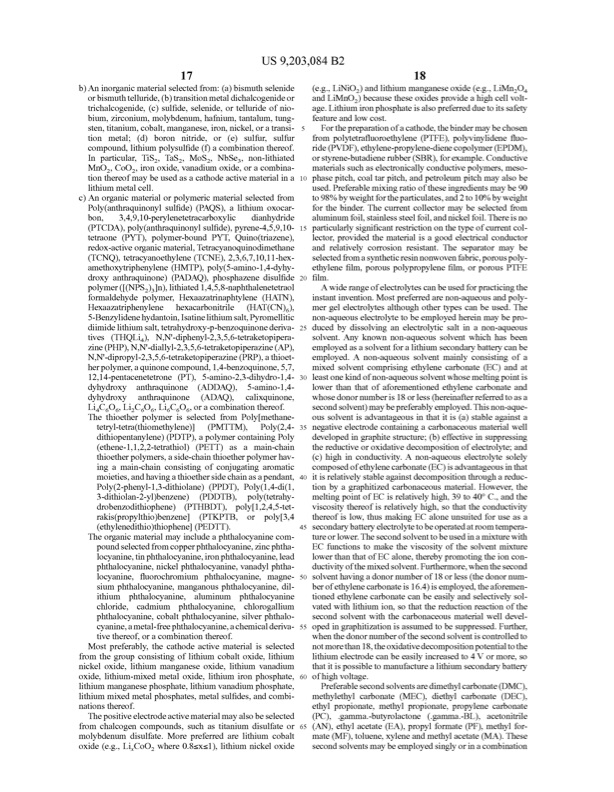
PDF Publication Title:
Text from PDF Page: 020
17 b)Aninorganicmaterialselectedfrom:(a)bismuthSelenide orbismuthteluride,(b)transitionmetaldichalcogenideor trichalcogenide,(c)sulfide,selenide,ortelurideofnio bium,Zirconium,molybdenum,hafnium,tantalum,tung sten,titanium,cobalt,manganese,iron,nickel,oratransi tion metal; (d) boron nitride, or (e) sulfur, sulfur compound,lithiumpolysulfide(f)acombinationthereof. Inparticular,TiS,TaS,MoS NbSe non-lithiated MnO,CoO,ironoxide,Vanadiumoxide,oracombina tionthereofmaybeusedasacathodeactivematerialina10 lithiummetalcell. 18 (e.g.,LiNiO)andlithiummanganeseoxide(e.g.,LiMn2O andLiMnO)becausetheseoxidesprovideahighcelvolt age.Lithiumironphosphateisalsopreferedduetoitssafety feature and low cost. Forthepreparationofacathode,thebindermaybechosen frompolytetrafluoroethylene(PTFE),polyvinylidenefluo ride(PVDF),ethylene-propylene-dienecopolymer(EPDM), orstyrene-butadienerubber(SBR),forexample.Conductive materialssuchaselectronicalyconductivepolymers,meso phasepitch,coaltarpitch,andpetroleumpitchmayalsobe used.Preferablemixingratiooftheseingredientsmaybe90 to98%byweightfortheparticulates,and2to10%byweight forthebinder.Thecurentcolectormaybeselectedfrom aluminumfoil,stainlesstelfoil,andnickelfoil.Thereisno particularlysignificantrestrictiononthetypeofcurentcol lector,providedthematerialisagoodelectricalconductor andrelativelycorrosionresistant.Theseparatormaybe selectedfromasyntheticresinnonwovenfabric,porouspoly ethylenefilm,porouspolypropylenefilm,orporousPTFE film. Hexaazatriphenylene hexacarbonitrile (HAT(CN)), 5-Benzylidenehydantoin,Isatinelithiumsalt,Pyromelitic diimidelithiumsalt,tetrahydroxy-p-benzoquinonederiva25 tives(THQLi.),N,N'-diphenyl-2,3,5,6-tetraketopipera zine(PHP),N,N'-dialyl-2,3,5,6-tetraketopiperazine(AP), N,N'-dipropyl-2,3,5,6-tetraketopiperazine(PRP),athioet herpolymer,aquinonecompound,1,4-benzoquinone,5.7. 12,14-pentacenetetrone(PT),5-amino-2,3-dihydro-1,4-30 dyhydroxy anthraquinone (ADDAQ), 5-amino-1,4- dyhydroxy anthraquinone (ADAQ), calixquinone, LiCO, Li2CO. LiCO, oracombinationthereof. ThethioetherpolymerisselectedfromPolymethane tetryl-tetra(thiomethylene) (PMTTM), Poly(2,4-35 dithiopentanylene)(PDTP),apolymercontainingPoly instantinvention.Mostpreferedarenon-aqueousandpoly mergelelectrolytesalthoughothertypescanbeused.The non-aqueouselectrolytetobeemployedhereinmaybepro ducedbydisolvinganelectrolyticsaltinanon-aqueous Solvent.Anyknownnon-aqueoussolventwhichhasbeen employedasasolventforalithiumsecondarybaterycanbe employed.Anon-aqueoussolventmainlyconsistingofa mixedsolventcomprisingethylenecarbonate(EC)andat leastonekindofnon-aqueoussolventwhosemeltingpointis lowerthanthatofaforementionedethylenecarbonateand whosedonornumberis18orles(hereinafterreferedtoasa secondsolvent)maybepreferablyemployed.Thisnon-aque oussolventisadvantageousinthatitis(a)stableagainsta negativeelectrodecontainingacarbonaceousmaterialwell developedingraphitestructure;(b)efectiveinSuppressing thereductiveoroxidativedecompositionofelectrolyte;and (c)highinconductivity.Anon-aqueouselectrolytesolely composedofethylenecarbonate(EC)isadvantageousinthat itisrelativelystableagainstdecompositionthroughareduc tionbyagraphitizedcarbonaceousmaterial.However,the meltingpointofECisrelativelyhigh,39to40°C.,andthe viscositythereofisrelativelyhigh,sothattheconductivity thereofislow,thusmakingECaloneunsuitedforuseasa secondarybateryelectrolytetobeoperatedatroomtempera tureorlower.Thesecondsolventtobeusedinamixturewith ECfunctionstomaketheviscosityofthesolventmixture lowerthanthatofECalone,therebypromotingtheioncon ductivityofthemixedsolvent.Furthermore,whenthesecond solventhavingadonornumberof18orles(thedonornum berofethylenecarbonateis16.4)isemployed,theaforemen tionedethylenecarbonatecanbeeasilyandselectivelysol vatedwithlithiumion,sothatthereductionreactionofthe secondsolventwiththecarbonaceousmaterialwelldevel opedingraphitizationisassumedtobeSuppressed.Further, when thedonornumberofthesecondsolventiscontrolledto notmorethan18,theoxidativedecompositionpotentialtothe lithiumelectrodecanbeeasilyincreasedto4Vormore,so thatitispossibletomanufacturealithiumsecondarybatery ofhighVoltage. (ethene-1,1,2,2-tetrathiol)(PETT)asamain-chain thioetherpolymers,aside-chainthioetherpolymerhav ingamain-chainconsistingofconjugatingaromatic moieties,andhavingathioethersidechainasapendant,40 Poly(2-phenyl-1,3-dithiolane)(PPDT),Poly(1,4-di(1, 3-dithiolan-2-yl)benzene) (PDDTB), poly(tetrahy drobenzodithiophene)(PTHBDT),poly1,2,4,5-tet rakis(propylthio)benzene (PTKPTB, or poly(3,4 (ethylenedithio)thiophene(PEDTT). Theorganicmaterialmayincludeaphthalocyaninecom poundselectedfromcopperphthalocyanine,Zincphtha locyanine,tinphthalocyanine,ironphthalocyanine,lead phthalocyanine,nickelphthalocyanine,Vanadylphtha locyanine,fluorochromiumphthalocyanine,magne50 siumphthalocyanine,manganousphthalocyanine,dil ithiumphthalocyanine,aluminumphthalocyanine chloride,cadmiumphthalocyanine,chlorogallium phthalocyanine,cobaltphthalocyanine,silverphthalo cyanine,ametal-frephthalocyanine,achemicalderiva55 tivethereof,oracombinationthereof. US9,203,084B2 c)Anorganicmaterialorpolymericmaterialselectedfrom Poly(anthraquinonylsulfide)(PAQS),alithiumoxocar bon, 3.4.9,10-perylenetetracarboxylic dianhydride (PTCDA),poly(anthraquinonylsulfide),pyrene-4.5,9,1015 tetraone(PYT),polymer-boundPYT,Quino(triazene), redox-activeorganicmaterial,Tetracyanoquinodimethane (TCNQ),tetracyanoethylene(TCNE),2,3,6,7,10,11-hex amethoxytriphenylene(HMTP),poly(5-amino-1,4-dyhy droxyanthraquinone)(PADAQ),phosphazenedisulfide polymer((NPS),n),lithiated1.4.5.8-naphthalenetetraol Awiderangeofelectrolytescanbeusedforpracticingthe formaldehydepolymer,Hexaazatrinaphtylene(HATN), 45 Mostpreferably,thecathodeactivematerialisselected fromthegroupconsistingoflithiumcobaltoxide,lithium nickeloxide,lithiummanganeseoxide,lithiumVanadium oxide,lithium-mixedmetaloxide,lithiumironphosphate,60 lithiummanganesephosphate,lithiumVanadiumphosphate, Preferablesecondsolventsaredimethylcarbonate(DMC), lithiummixedmetalphosphates,metalsulfides,andcombi nationsthereof. Thepositiveelectrodeactivematerialmayalsobeselected fromchalcogencompounds,Suchastitaniumdisulfateor65 molybdenumdisulfate.Morepreferedarelithiumcobalt oxide(e.g.,LiCoOwhere0.8sXs1),lithiumnickeloxide methylethylcarbonate(MEC),diethylcarbonate(DEC), ethylpropionate,methylpropionate,propylenecarbonate (PC),gamma.-butyrolactone(gamma.-BL),acetonitrile (AN),ethylacetate(EA),propylformate(PF),methylfor mate(MF),toluene,xyleneandmethylacetate(MA).These secondsolventsmaybeemployedsinglyorinacombinationPDF Image | CATHODE ACTIVE MATERIAL-COATED DISCRETE GRAPHENE SHEETS FOR LITHIUM

PDF Search Title:
CATHODE ACTIVE MATERIAL-COATED DISCRETE GRAPHENE SHEETS FOR LITHIUMOriginal File Name Searched:
US9203084.pdfDIY PDF Search: Google It | Yahoo | Bing
Sulfur Deposition on Carbon Nanofibers using Supercritical CO2 Sulfur Deposition on Carbon Nanofibers using Supercritical CO2. Gamma sulfur also known as mother of pearl sulfur and nacreous sulfur... More Info
CO2 Organic Rankine Cycle Experimenter Platform The supercritical CO2 phase change system is both a heat pump and organic rankine cycle which can be used for those purposes and as a supercritical extractor for advanced subcritical and supercritical extraction technology. Uses include producing nanoparticles, precious metal CO2 extraction, lithium battery recycling, and other applications... More Info
| CONTACT TEL: 608-238-6001 Email: greg@infinityturbine.com | RSS | AMP |